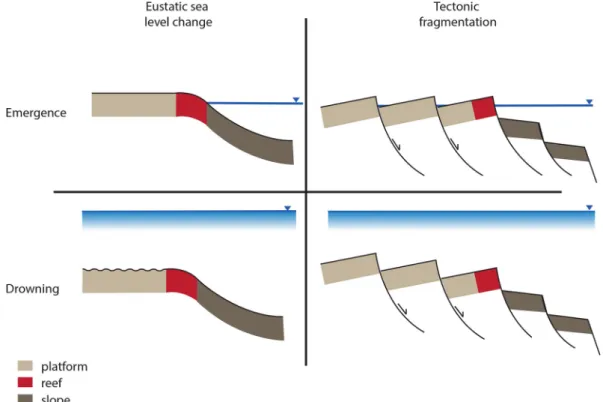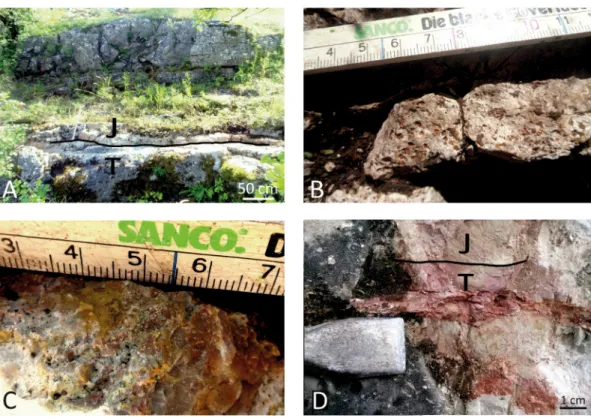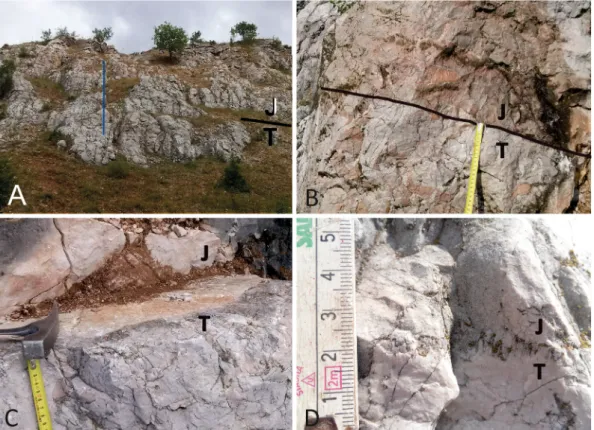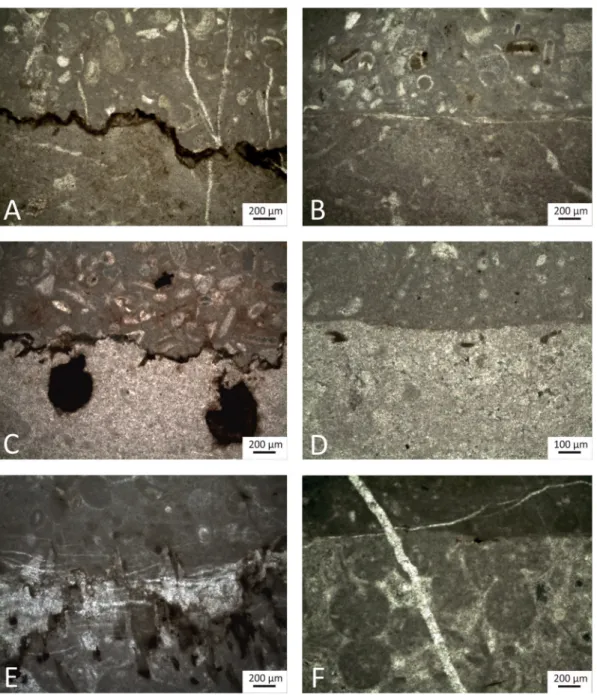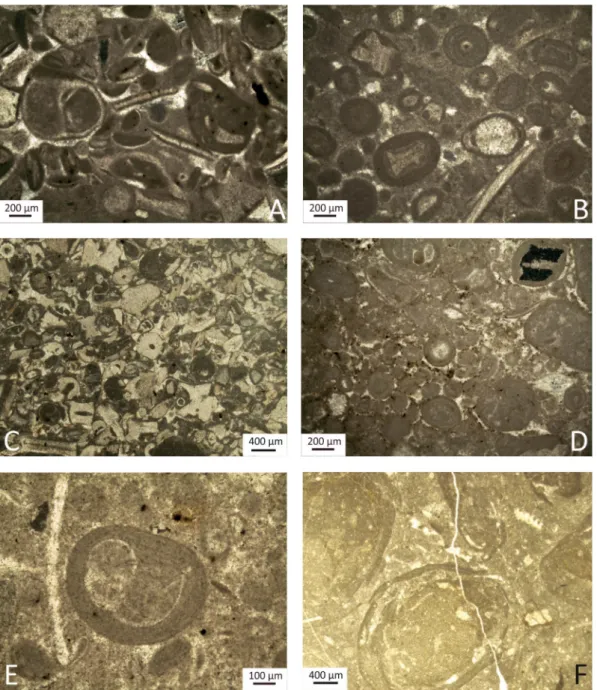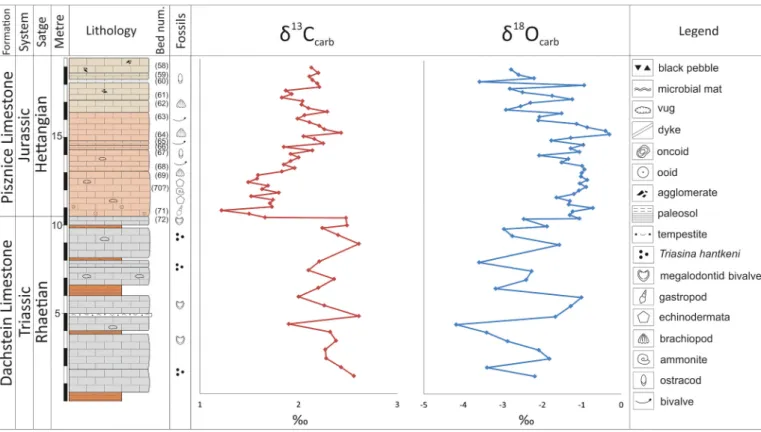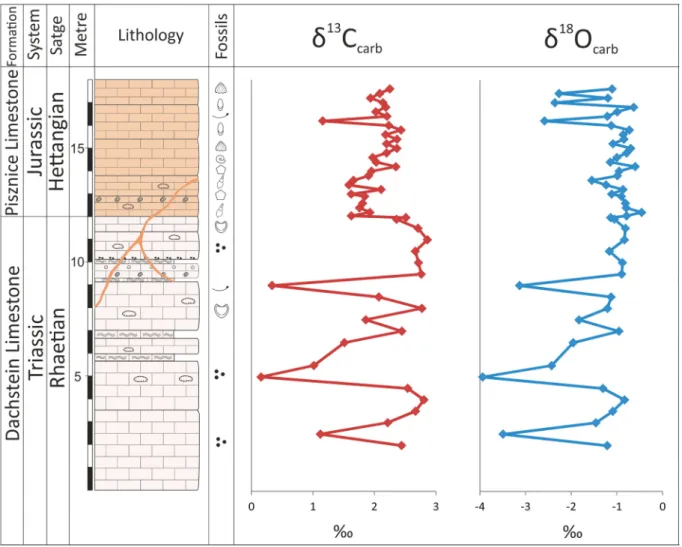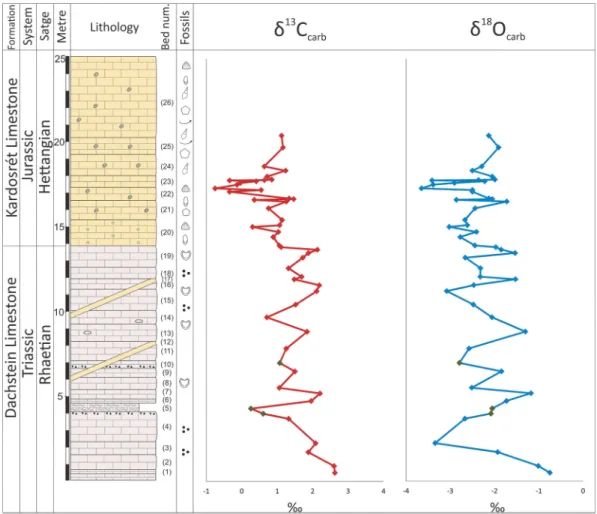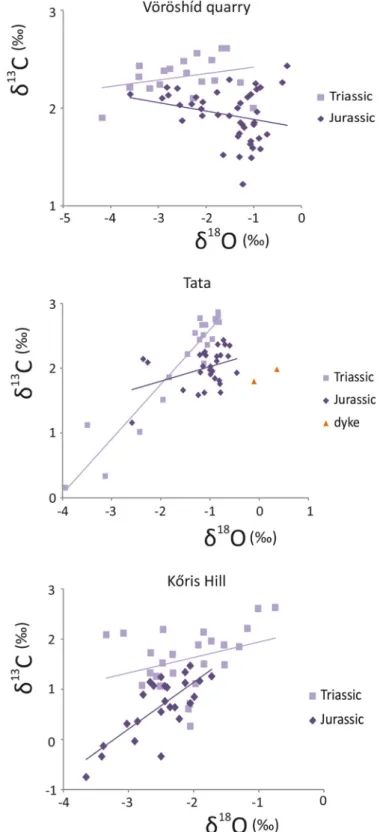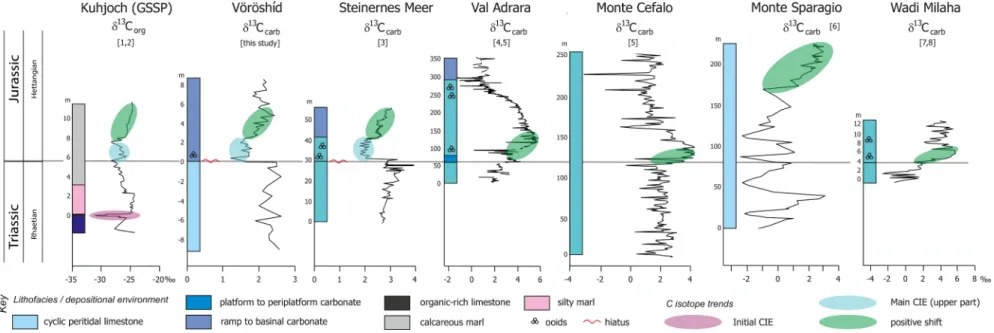Global and Planetary Change 199 (2021) 103428
Available online 20 January 2021
0921-8181/© 2021 The Author(s). Published by Elsevier B.V. This is an open access article under the CC BY license (http://creativecommons.org/licenses/by/4.0/).
End-Triassic crisis and “ unreefing ” led to the demise of the Dachstein carbonate platform: A revised model and evidence from the Transdanubian Range, Hungary
J ´ ozsef P ´ alfy
a,b,*, Zs ofia Kov ´ ´ acs
a,c,d,e, Attila Dem ´ eny
f, Zsolt Vallner
a,caDepartment of Geology, E¨otv¨os Lor´and University, Budapest H-1117, Hungary
bMTA–MTM–ELTE Research Group for Paleontology, POB 137, Budapest H-1431, Hungary
cIsotope Climatology and Environmental Research Centre (ICER), Institute for Nuclear Research, Bem square 18/C, Debrecen H-4026, Hungary
dInstitute for Earth Sciences (Geology and Paleontology), University of Graz, Heinrichstrasse 26, Graz 8010, Austria
eDepartment of Geology, University of Lund, S¨olvegatan 12, Lund 22362, Sweden
fResearch Centre for Astronomy and Earth Sciences, Institute for Geological and Geochemical Research, Buda¨orsi út 45, Budapest H-1112, Hungary
A R T I C L E I N F O Keywords:
Triassic-Jurassic boundary Carbon isotope Platform drowning Submarine erosion Ecosystem collapse Astrochronology
A B S T R A C T
The Dachstein platform was an extensive carbonate platform developed on the westernmost shelf of the Neo- tethys during the Late Triassic, now preserved in various tectonic units disrupted during the Alpine orogeny.
Despite being the focus of a multitude of sedimentological, paleontological and other studies, the demise of this platform remains controversial, with contrasting views on the timing and causes of cessation of its growth, the duration of the gap above, which at many places includes the Triassic-Jurassic boundary (TJB), and the depo- sitional environment of overlying strata.
Here we present new carbonate sedimentological, stable isotope and cyclostratigraphic data from sections in the Transdanubian Range (Hungary) which capture the termination of uppermost Triassic Dachstein Limestone and the onset of Hettangian (Early Jurassic) sedimentation following a hiatus. Previously, the TJB in the Transdanubian Range was regarded as a textbook case of a tectonically-driven platform drowning event or, alternatively, cessation of carbonate production due to emergence caused by a significant sea level fall at the TJB.
However, recognition of global biotic change and environmental perturbations at the TJB calls for an assessment of their possible role in the demise of the Dachstein platform.
Oxygen and carbon isotopic composition of bulk carbonates were measured in sections at K˝oris-hegy (Bakony Mts.), Tata (Tata Horst), and V¨or¨oshíd (Gerecse Mts.) Paleogeographically, these three sections represent a proximal to distal platform transect. Other sections at Pisznice and T¨olgyh´at (Gerecse Mts.) yielded additional sedimentological data. The sharp surface separating the Dachstein Limestone from the overlying Jurassic for- mations carries no or only minimal relief at outcrop scale. Thin section studies reveal small-scale irregularities, stylolites, microborings with ferruginous filling, or a thin clay-rich layer at the TJB, indicative of a submarine, or perhaps polygenetic, hardground. In the first meters of the lowermost Jurassic beds abundant ooids occur, and crinoids become common. In each of the studied sections, an abrupt negative carbon isotope shift is recorded at the TJB, and a gradual rebound to more positive values characterizes the lowermost Jurassic strata. Chemo- stratigraphy allows correlation with sections elsewhere. In the Transdanubian Range, the initial carbon isotope excursion and at least the first part of the purported main carbon isotope excursion are not preserved due to the gap at the TJB. Combined bio- and cyclostratigraphy of lowermost Jurassic strata permits an astrochronologic duration estimate of the early Hettangian hiatus that was not longer than a few hundreds of thousand years.
Our results highlight the role of submarine erosion, perhaps partly related to acidification, and point to an abrupt change in carbonate production related to the end-Triassic extinction of several groups in the platform system. “Unreefing”, the ecological collapse of reefs, led to a regime shift, the transformation of the rimmed platform to a carbonate ramp, with a significant gap in production and preservation of carbonate sediment. This model is not uniformly applicable to Late Triassic platforms as several of them, unlike the Dachstein platform,
* Corresponding author at: Department of Geology, E¨otvos Lor¨ ´and University, Budapest H-1117, Hungary E-mail address: palfy@elte.hu (J. P´alfy).
Contents lists available at ScienceDirect
Global and Planetary Change
journal homepage: www.elsevier.com/locate/gloplacha
https://doi.org/10.1016/j.gloplacha.2021.103428
Received 30 April 2020; Received in revised form 9 January 2021; Accepted 13 January 2021
survived with unrimmed architecture in the Early Jurassic elsewhere on the Neotethyan shelf. However, the model may explain features of the carbonate platform sedimentary record across other events with reef collapse.
1. Introduction
The Dachstein carbonate platform is one of the most extensive and best studied Phanerozoic carbonate platforms that developed on the westernmost Neotethyan shelf during the Late Triassic. The Dachstein platform occupied parts of a broad, up to 300 km-wide shelf belt on the European passive margin (Krystyn et al. 2005) where an up to 2 km- thick succession of alternating well-bedded to massive and stromatolitic dolomite, the Main Dolomite (Hauptdolomit) Formation and the over- lying (and partly laterally adjacent) limestone with prominent cyclicity, the Dachstein Formation was deposited from late Carnian to Rhaetian time. The Dachstein platform was dismembered during the Alpine orogeny but its originally contiguous parts are now preserved in the Austroalpine Units in the classical type area of the Northern Calcareous Alps and also in the Transdanubian Range in Hungary (Haas et al. 1995).
Although these shallow marine carbonates have been in the focus of many classical and modern studies, some important issues remain debated. Cyclic stratal patterns in the Dachstein Formation were described as Lofer cycles composed of members A, B, and C that were formed in supra-, inter-, and subtidal depositional environments, respectively, and interpreted to reflect orbitally controlled sea-level changes in peritidal deposits (Fischer 1964; Haas, 1994; Enos and Samankassou 1998; Haas et al. 2007). Lagoons of the inner Dachstein platform in the Northern Calcareous Alps were fringed by prolific reefs that harbored a rich biota (Bernecker 2005; Martindale et al. 2013): the Dachstein reefs faced the open oceanic Hallstatt Basin whereas on the opposing side the Rhaetian Oberrhatkalk ¨ reefs bordered intraplatform basins such as the Eiberg Basin (Mandl 2000). However, the timing and causes of demise of the Dachstein platform system remain controversial.
Although locally the shallow marine limestone is overlain by middle
Rhaetian basinal deposits (Krystyn et al. 2009), elsewhere deposition of the Dachstein Formation continued until the end of the Rhaetian (Mis- soni and Gawlick 2011). Termination of shallow marine platform sedi- mentation is most commonly interpreted as a drowning event related to the onset of extensional tectonics (Mandl 2000), but cessation of growth of a reef complex at Steinplatte was also ascribed to rapid sea level fall of an estimated 150 m (Krystyn et al. 2005). Only a few authors speculated that the ecological consequences of the end-Triassic mass extinction may have also played a significant role (Gawlick et al. 1999, 2009).
In the Transdanubian Range, the Main Dolomite and Dachstein Limestone are the areally and volumetrically most extensive formations.
Termination of platform growth, and the unconformity at the top of the Dachstein Formation have long been regarded to mark the Triassic- Jurassic boundary (TJB), as overlying Jurassic strata are lithologically different and a hiatus of variable duration is present across the entire Transdanubian Range. Stratigraphic studies in the Bakony Mts., Tata Horst and Gerecse Mts. led to different interpretations about the demise of the Late Triassic Dachstein platform, either due to emergence or drowning, both potentially ascribed to either eustatic sea level change or synsedimentary tectonic forcing (Fig. 1). Emergence and subaerial exposure were suggested in studies of TJB sections both in the Gerecse (Vigh 1936, 1961a, 1961b) and Bakony Mts. (Cs´asz´ar and Oravecz- Scheffer 1987). On the contrary Haas (1995a, 1995b), inferred plat- form drowning both in the Bakony and Gerecse Mts., where subsidence was explained by incipient rifting of the Ligurian-Penninic oceanic branch and related regional extension in the Transdanubian Range (Vor¨¨os and Gal´acz 1998). Here basin-scale differential subsidence dominated from the Early Jurassic but tilted blocks along listric normal faults may have led to temporary emergence of parts of the platform. A detailed study of the Tata Horst led to a tentative suggestion of
Fig. 1. Contrasting models proposed previously to explain the demise of the Dachstein platform in the Transdanubian Range. Emergence by sea level fall was proposed by Vigh (1933, 1961) (see upper left), possibly in combination with tectonic fragmentation (Gy˝ori 2014) (upper right). Drowning with a role of submarine dissolution and erosion suggested by Fül¨op (1976) (lower left), tectonic subsidence emphasized by Haas et al. (1995) (lower right).
submarine dissolution as an alternative explanation of the TJB surface on top of the Dachstein Fm (Fül¨op 1976).
Recently, a multitude of studies emphasized the significance of the end-Triassic extinction and concomitant environmental changes for the entire Earth system, as reviewed by Palfy and Kocsis (2014). Notably, ´ runaway greenhouse warming (McElwain et al. 1999), perturbation of the carbon cycle (P´alfy et al. 2001; Ward et al. 2001; Hesselbo et al.
2002), ocean acidification (Hautmann 2004; Greene et al. 2012), and a major crisis of reef ecosystems (Kiessling et al. 2007) represent potential factors affecting the health and growth of a carbonate platform, which has not yet been fully explored in connection with the fate of the Dachstein platform (Haas et al. 2018).
Here we present the results of a multifaceted study of TJB sections from the Transdanubian Range (Hungary) which record the disconfor- mity that marks the top of the Dachstein Limestone. Sections in our study areas in the Transdanubian Range are closely correlative to the type area of the formation in the Northern Calcareous Alps in Austria.
Whereas previous studies emphasized the role of either tectonically- driven drowning and disintegration of the platform, or emergence due to sea level drop at the TJB, the role of other environmental and ecological changes related to the end-Triassic extinction has received much less attention. Our aim is to generate new stratigraphic data from multiple sections in the Transdanubian Range, through combined application of carbonate sedimentology and stable isotope chemo- stratigraphy, while also obtaining additional constraints from bio- and cyclostratigraphy. The new results are then interpreted in the context of possible causes and processes of the demise of Dachstein platform and the resumption of sedimentation during the earliest Jurassic biotic re- covery. We demonstrate that environmental and biotic changes were fundamental drivers, more important than previously recognized.
2. Geological setting
The lower Mesozoic succession of the Transdanubian Range was deposited at the passive margin of the Neotethys and later the newly opening Alpine Tethys, thus its basin evolution was controlled by tec- tonic processes related to the opening of the Neotethys and Ligurian- Penninic oceanic branches (Haas et al. 1995). Early phase of rifting in the Middle Triassic was followed by filling up the basin during the Carnian, leading to the development of a large platform system. The Main Dolomite (Hauptdolomit or Dolomia Principale in German and Italian literature, respectively) and the overlying Dachstein Limestone together represent an extensive, tropical shallow carbonate platform system with a combined thickness in excess of 2 km in the Trans- danubian Range (Fig. 2) (Haas 2004). Other parts of the once contiguous platform system, disrupted by later phases of tectonic evolution related to the Alpine orogeny, are preserved in the Upper Austroalpine nappe system of the Northern Calcareous Alps, with more distant analogues in the Southern Alps (Haas et al. 1995).
The Jurassic succession of the Transdanubian Range, in sharp contrast to the Upper Triassic, is much less thick, ~500 m in the Zala Basin southwest of the Bakony but thinning significantly to the east in the Gerecse (V¨or¨os and Gal´acz 1998). Facies variability in the Bakony and Gerecse is expressed in contrasting types of successions, continuous sections and those with gaps, especially after marked differentiation of basin floor topography starting in the Sinemurian. In the Bakony, the Dachstein Limestone is paraconformably overlain by ooidal-oncoidal limestone of the Kardosr´et Formation, an up to 200 m thick shallow marine deposit, that distinctly lacks Lofer cyclicity (i.e. facies stacking of subtidal, peritidal and supratidal origin) (Haas 1995a). This unit is pinching out to the northwest, and in Tata and the Gerecse the lower- most Jurassic Pisznice Limestone rests upon the disconformity surface at the top of Dachstein Fm. Ammonites and brachiopods suggest that at Tata and some localities in the Gerecse the basal, massively bedded part of this formation could be at least as old as middle Hettangian (Dulai 1998; P´alfy et al. 2007). Upsection, Sinemurian and Pliensbachian strata
in this formation record a transition from neritic to increasingly pelagic depositional environment (Budai et al., 2018). The Schnoll Fm. ¨ (formerly included in the Adnet Fm.) represents the closest analogue in the Upper Austroalpine units in the Northern Calcareous Alps (Cs´asz´ar et al. 1998; Haas et al. 2011).
Paleogeographic reconstruction of the Hauptdolomit/Dachstein carbonate platform and overlying lowermost Jurassic deposits is confounded by its dismemberment into thrust sheets that form the nappe stack of the Austroalpine Units exposed in the Northern Calcareous Alps (Gawlick et al. 2009). Although truncated by the Balaton line and the Mid-Hungarian shear zone in the south and concealed under the Neogene cover in the Danube basin in the north, the allochthonous Transdanubian Range is thought to represent the uppermost unit within the Austroalpine nappe stack formed in the Cretaceous (Tari and Horv´ath 2010). Parts of the Dachstein platform as preserved in the Northern Calcareous Alps and in the Transdanubian Range are now disjunct parts of the Alcapa terrane (Csontos and Vor¨os 2004), separated ¨ by major Cenozoic lateral extrusion (Ratschbacher et al. 1991). How- ever, data from both areas are equally important for understanding the evolution and demise of this platform system. Paleogeographic re- constructions suggest that the Late Triassic position of the Trans- danubian Range was intermediate between the Upper Austroalpine units of the Northern Calcareous Alps and the Southern Alps (Haas et al. 1995;
Mandl 2000), and alignment of facies belts should take into account a Cenozoic counterclockwise rotation of up to 75–90◦ (M´arton and M´arton 1981; M´arton and Fodor 2003).
3. Stratigraphy and the TJB in the studied sections
3.1. Gerecse 3.1.1. T¨olgyh´at
The Tolgyh¨ ´at quarry represents the most complete and thickest Jurassic succession in the Gerecse, briefly described by Konda (1988). In Fig. 2.Location map of the study area in the Transdanubian Range. (A) Index map showing the Transdanubian Range (TR) tectonic unit within Hungary (H) and its geographic context within Europe. (SK: Slovakia, U: Ukraine, RO:
Romania, SRB: Serbia, HR: Croatia, SL: Slovenia, A: Austria.) (B) Location of the studied sections and areal extent (grey-shaded areas) of surface exposure of Upper Triassic platform carbonates (after Haas 2002).
this abandoned quarry on the north slope of Gerecse (Fig. 2, 47◦43′22.11” N, 18◦30′44.76′′ E), the lowermost 3 m exposes the topmost layers of Dachstein Fm., here mainly consisting of light grey, thick-bedded limestone with calcite specks (i.e. recrystallized tests of the foraminifer Triasina hantkeni). The uppermost one-cm-thick purple layer with fenestral pores is member B of a Lofer cyclothem in the of the Dachstein Fm., overlying a similarly thin layer of clayey limestone (Fig. 3D) that in turn rests upon an irregularly eroded top surface of member A with cm-scale relief. The boundary between the Dachstein Fm. and the paraconformably overlying poorly bedded, massive Pisznice Fm. is sharp and planar (Fig. 3D). Macrofauna in the lowermost Jurassic beds of Pisznice Fm. consists of brachiopods, Dulai (1998) reported the occurrence of 9 species from the basal 3.5 m.
3.1.2. Nagy-Pisznice
Near the SW corner of a large abandoned quarry on Nagy-Pisznice Hill, a natural outcrop (47◦41′56.90” N, 18◦29′24′′E) exposes c. 3 m of strata across the TJB (Fig. 3A). The topmost, 70-cm-thick bed of Dachstein Fm. comprises grey, micritic limestone that represents member C of a Lofer cyclothem. The lowermost, c. 20-cm-thick, crinoid- bearing light pink limestone beds of the overlying Pisznice Fm. contain rare brachiopods. Some 0.5 m above the TJB the beds become darker, more crinoid-rich and contain intraclasts, with increasingly stylolitic bedding planes. The formation boundary, hence the TJB, is a sharp and slightly irregular, pockmarked surface (Fig. 3A, B). The shallow de- pressions are commonly filled with ferruginous material or green clay, the latter also occurs as coating, void fills or clasts in the basal Jurassic layer (Fig. 3C). The Nagy-Pisznice quarry section was briefly described by Konda (1985).
3.1.3. V¨or¨oshíd
The abandoned V¨or¨oshíd quarry (47◦41′28.38” N, 18◦27′47.90′′E) exposes c. 30 m of the Dachstein Fm. and the overlying Pisznice Fm.
(Figs. 4A, S1), providing the best exposure of the TJB in the Gerecse Mts.
The Dachstein Fm. comprises well-developed Lofer cyclothems, domi- nated by thick layers of member C, including the topmost Triassic bed that contains abundant foraminifers (Triasina hantkeni) and large-sized (10–15 cm) molds of megalodontid bivalves. Some of these molds and additional irregular shaped voids are filled with pink, at some places laminated micritic or crinoidal limestone, genetically related to the overlying Jurassic limestone. The molds and void fills are commonly surrounded by isopachous radiaxial calcite cement of up to 4 mm in width.
Above a 5-cm-thick basal layer, the lower 8 m of the overlying Pisznice Fm. is light pink, thick-bedded, and slightly crinoidal. As in the Dachstein Fm., the lowermost Pisznice Fm. also contains irregular sha- ped, commonly horizontally elongated voids, with or without an iso- pachous cement envelope (Fig. 4B). The lowermost 1 m in the Jurassic contains abundant coated grains, whereas higher up crinoid bioclasts become more common, often enriched in pockets with diffuse boundary.
Upsection, the next 7 m consists of more thinly-bedded and darker brownish-red limestone.
The contact between the two formations at the TJB is sharp, at some places perfectly planar (Fig. 4B, C), elsewhere with stylolites of 0.5 cm amplitude (Fig. 4D). Truncated molds of large-sized megalodontid bi- valves are a spectacular feature of this locality (Lantos 1997). The lower, thick-bedded part yielded a brachiopod fauna of 10 species (Dulai 1998); rare ammonoids also occur 100–130 cm above the TJB but could not be extracted. The oldest identifiable ammonites were found higher, in the thin-bedded member, and indicate Early Sinemurian age (Dulai 1998). The V¨or¨oshíd quarry section was briefly described by Konda (1987). The inferred basin margin depositional environment of Sine- murian strata reflects the evolution of dissected paleotopography after termination of uniform Late Triassic Dachstein platform (Lantos 1997).
3.2. Tata (K´alv´aria-domb)
In the abandoned quarry yard (47◦38′21.56” N, 18◦18′54.04′′ E)
Fig. 3.The TJB in the Pisznice (A–C) and T¨olgyh´at (D) sections. (A) View of sharp, undulating TJB surface in the Pisznice section. (B) Rounded borings of few mm in diameter with ferruginous filling on the top surface of Dachstein Fm. (Scale in cm.) (C) Thin, green clay film at the TJB surface. (Scale in cm.) (D) Sharp, planar TJB surface above member B in the topmost bed of Dachstein Fm. (For interpretation of the references to color in this figure legend, the reader is referred to the web version of this article.)
beneath the Calvary statues outside the Geological Garden in Tata (Haas and H´amor 2001), the uppermost part of Dachstein Fm. and lowermost part of Pisznice Fm. are exposed in a combined thickness of 18 m (Fig. 5C). Members C and B dominate the Lofer cyclothems in the up- permost Triassic. Thick beds of member C contain several types of voids, including molds after large megalodontid bivalves and cavities of irregular shape, both are commonly filled with red micrite within a white fibrous calcite envelope (Gyori 2014) (Fig. 5A). Members B occur ˝ as 10–25 cm thick laminated layers of microbial mat origin. Rare black pebbles and traces of paleosol indicate the presence of member A. A network of neptunian dykes with red Jurassic micritic limestone fill crosscuts the uppermost part of the Dachstein Fm. (Fig. 5D).
The contact between the two formations is near perfectly planar.
Laterally, not along the sampled profile but elsewhere within the Geological Garden, the topmost bedding plane of the Dachstein Fm. is exposed extensively. Its surface is densely covered with shallow, rounded, unfilled depressions of 0.5–2.5 mm diameter (Fig. 5B), the adjacent ones are commonly merged. In the basal part of the overlying massive to thick-bedded pink limestone of the Pisznice Fm., an interval 50 to 90 cm above the TJB contains abundant coated grains and some coated macrofossils. The Mesozoic section of the Tata horst has a long history of study (Koch 1909; Szab´o 1961) culminating in the monograph of Fül¨op (1976), who surmised on the significance of the TJB surface and first suggested the possibility of submarine erosion. Later studies also considered the complexity of the issue but observed some 1.5 m differ- ence at outcrop-scale in the truncated top of the Dachstein Fm. and argued for emergence and subaerial erosion (Haas et al. 2018).
In the first biostratigraphic study at Tata (Koch 1909) the TJB was recognized after assigning a Rhaetian age for the Dachstein Limestone based on its megalodontid bivalve fauna and a middle or upper Het- tangian age for the basal Jurassic on the basis of ammonoid finds, also noting the common brachiopods. Szabo (1961) ´ identified further
ammonoid taxa and agreed with a mid-Hettangian age assignment (Megastoma Zone as defined in the Alps) for the oldest Jurassic strata, explaining the hiatus above the Dachstein Limestone with tectonic ac- tivity. Within the monographic treatment of the geology of Tata (Fülop ¨ 1976), G´eczy re-studied the lowermost Jurassic ammonoids and found no firm evidence for Jurassic older than the Upper Hettangian Mar- morea Zone. A more recent study suggested the presence of Alsatites, Discamphiceras, and Paracaloceras, on the basis of distinctive cross sec- tions of inextractable specimens in an oncoidal layer 30–70 cm above the TJB (P´alfy et al. 2007). This assemblage may hint at the presence of the mid to late Hettangian (upper Megastoma and lower Marmorea Zone in the Alpine zonation).
3.3. Bakony (K˝oris-hegy)
The stratigraphy of the TJB transition in the Bakony Mts. is similar to the Gerecse and Tata in the Upper Triassic, but differs in the lowermost Jurassic as the Dachstein Fm. here is overlain by the Kardosr´et Fm. The best exposure of the TJB strata is an artificial trench on the south slope of K˝oris-hegy (47◦16′59.83” N, 17◦45′18.99′′E), exposing c. 25 m of strata across the boundary. The topmost 12 m of the Dachstein Fm. dominantly comprises beds of member C of the Lofer cyclothems, thin beds of member A and B occur only sparsely. The Dachstein Fm. is locally cut by two steep neptunian dykes. Some beds yield megalondontid bivalves.
The TJB is expressed by a contrast in color across a nearly planar surface.
The lowermost Jurassic Kardosr´et Fm. is thick-bedded, grey, yellow, and pink in color, and contains rare macrofossils (gastropods and brachio- pods). The K˝oris-hegy section was briefly described by Cs´asz´ar and Oravecz-Scheffer (1987).
Fig. 4. The TJB in the V¨or¨oshíd quarry section. (A) View of the quarry wall showing the position of TJB and location of the 19.5 m thick profile sampled for stable isotope analyses. (B) Cavities of irregular shape occurring both in the Dachstein and Pisznice Fm., filled by red micrite, in some cases surrounded by isopachous white calcite cement. (C) Planar TJB surface. (D) Stylolytes with amplitude of 0.5 cm at the TJB. (For interpretation of the references to color in this figure legend, the reader is referred to the web version of this article.)
4. Material and methods 4.1. Carbonate petrography
More than 30 thin sections of 5 ×5, 7 ×7 and 10 ×7 cm size were made from samples in the three measured sections; the larger-sized ones were especially useful to study the TJB surface across the top of the Dachstein Fm. At Tolgyh¨ ´at and V¨or¨oshíd, TJB samples were obtained using a drill corer. Archive thin sections of each bed of the Koris-hegy ˝ section, made during the 1980’s effort of documenting key stratigraphic sections in Hungary by the Geological Institute of Hungary, were made available to us and restudied. Petrographic descriptions follow the textural classification scheme of Dunham (1962). On the basis of component grain types and their abundance distribution, matrix type, sedimentary structures and fossils, samples were assigned to standard microfacies (SMF), using the 26 SMF types distinguished by Flügel and Munnecke (2010).
4.2. Stable isotope geochemistry
In the V¨oroshíd quarry, the topmost 9 m of the Dachstein Fm. was ¨ sampled on average at 50 cm intervals, more densely near the TJB, whereas 20 cm spacing was used in sampling the lower 8.5 m of the Pisznice Fm., comprising its lower, thick-bedded unit. The sampled profile is located approximately at the northern third of the rock face in the upper quarry yard (Fig. S1).
In Tata, the TJB profile beneath the Calvary statue (Fig. 5C) was
sampled at a 50 cm spacing in the uppermost 12 m of the Dachstein Fm.
Beds of member B were avoided and 21 samples were obtained from member C beds only; sampling density was increased immediately below the boundary. The lower 5.6 m of the Pisznice Fm. was sampled uniformly at every 20 cm. In addition, two samples of Jurassic neptunian dyke fill (Fig. 5D) within the Dachstein Fm. were also collected.
From K˝oris-hegy, a first sampling effort in 2007 obtained 43 samples from 20.5 m of the stratigraphic section. This was supplemented by additional samples from the upper 4.5 m of the Kardosr´et Fm. exposed here.
In total we analyzed 164 bulk carbonate samples for δ13Ccarb and δ18Ocarb at the Institute for Geological and Geochemical Research (IGGR, Budapest, Hungary). After cutting and cleaning the samples we targeted and drilled the most homogeneous micritic fraction. Stable carbon and oxygen isotope compositions were determined by reacting carbonate powder samples (150–200 μg) with orthophosphoric acid at 72 ◦C (Spotl ¨ and Vennemann 2003) and analyzing the evolved CO2 by an automated GASBENCH II sample preparation device attached to a Thermo Finnigan Delta Plus XP isotope ratio mass spectrometer (IRMS). Three laboratory standards calibrated with the NBS-18, NBS-19 and LSVEC standards (provided by the International Atomic Energy Agency) were used for inter- and cross-laboratory standardization. A Harding Iceland Spar (Landis 1983) sample was measured as unknown in the course of the study, and yielded δ13C and δ18O values of − 4.92 ±0.09‰ and − 18.50
±0.09‰ (n =28), respectively. These values are close to the published values of − 4.80 and − 18.56‰, respectively (Landis 1983). On the basis of these results, the accuracy and reproducibility of δ13C and δ18O values Fig. 5.The TJB in the Tata (Kalv´ ´aria-domb) section. (A) Molds of megalodontid bivalves and irregular cavities filled by red micrite, surrounded by isopachous white fibrous calcite cement. (B) Densely spaced, rounded, shallow depressions, 0.5–2.5 mm in diameter, interpreted as borings on the top surface of Dachstein Fm. (C) View of the quarry wall showing the position of TJB and location of the profile sampled for stable isotope analyses. (D) Wide neptunian dyke (dotted outline) with micritic infill and broken clasts cutting through the topmost Rhaetian Dachstein Fm. (Photos A and D by Orsolya Gy˝ori.) (For interpretation of the references to color in this figure legend, the reader is referred to the web version of this article.)
are better than ±0.1‰.
Stable isotope curves were compiled from 62, 50, and 50 measure- ments on samples from the sections of V¨or¨oshíd quarry, Tata, and K˝oris- hegy, respectively. Additional data were obtained from Tata, where two samples that represent the Jurassic infill of neptunian dykes were measured, to supplement results of a previous study of Gy˝ori (2014) that reports data from seven analyses partly also from neptunian dykes and partly from vugs in the Triassic limestone filled with Jurassic micrite.
4.3. Cyclostratigraphy
In a previous study, the 10 m thick lower, massive to thick-bedded part of the Pisznice Fm. that directly overlies the TJB surface in the K´alv´aria-domb section at Tata was subjected to detailed and high- resolution carbonate microfacies analysis using thin sections made perpendicular to bedding at 5 cm sampling interval (Fül¨op 1976). From
the abundance distribution of components in 200 successive thin sec- tions plotted in text-fig. 20 in Fül¨op (1976), we digitally read values of Globochaete alpina (spherical calcified planktonic green algae, Flügel and Munnecke 2010), sum of foraminifera, sponge spicules, crinoids, gastropods and ostracods, using Webplot Digitizer. These six time series from the raw data was supplemented by calculated ratios of sponge spicules to crinoids, Globochaete, and ostracods, and gastropods to Glo- bochaete. For cyclostratigraphic analysis, these datasets are regarded to result from even-spaced channel sampling that represent continuous time series. Analyses were performed using the Acycle software (Li et al.
2019). Time series were checked for outliers, removal of no more than five outlier values were needed in any of the datasets, omitted data was substituted by interpolation to 5 cm. To avoid zero values in time series, in such cases 1 was added to each value to allow log-transformation.
Sponge spicule, gastropod and ostracod datasets and the ratios were log-transformed. For detrending either the LOWESS (at 35%) or LOESS
Fig. 6. Photomicrographs of various features observed at the TJB surface in the studied sections. (A) Clay residue along the TJB surface enhanced by pressure- solution (T¨olgyh´at). (B) Calcite cement precipitated along the sharp, planar TJB surface (T¨olgyh´at). (C) Wavy, stylolitic TJB surface coated with insoluble res- idue, with borings of c. 400 μm diameter immediately beneath (Pisznice). (D) Elongated borings of c. 100 μm length beneath and parallel to the TJB (Pisznice). (E) Columnar, serrated stylolytic TJB surface with calcite cement precipitates (V¨or¨oshíd). (F) Crustacean fecal pellets truncated at the TJB surface (K˝oris-hegy).
(at 40%) trend was removed from the time series. Power spectral anal- ysis used the 2π multi-taper method (MTM) (Thomson 1982, 1990) and zero-padding. Confidence levels were calculated using the robust version of autoregression model. Construction of spectrograms (evolu- tionary power spectra) employed a sliding window of 380 cm and 5 cm steps. Band-pass filtering was carried out for each time series using the Gauss algorithm on the lowest-frequency cycle. Wavelet analysis was used to test for possible stratigraphic gaps.
5. Results
5.1. Characteristics of the TJB boundary surface
Microscopic features of the top boundary of the Dachstein Fm., that represents the TJB, display both similarities among and some differences
between the studied sections. At T¨olgyh´at, the formation boundary is at some places stylolitic where the amplitude of surface irregularities is up to 200 μm. The thickness of the residual clay layer at the pressure so- lution surfaces is 50–100 μm (Fig. 6A). Carbonate component grains in the Pisznice Fm. are damaged at the stylolitic surface. Elsewhere the contact is gently undulating, nearly planar, and bears a thin cement layer (Fig. 6B). Multiple styles of the boundary surface also characterize the locality of Nagy-Pisznice, where contrasts may occur within a single thin section. Pressure solution is expressed in wavy or serrated stylolites of 200–600 μm amplitude, whose surface is coated with 25–100 μm thick brown dissolution residue (Fig. 6C). Overprint of the original surface and solution affected the integrity of components in the Jurassic carbonate. Elsewhere the boundary surface is planar or only mildly undulating, with a relief not exceeding 2 mm, and lacks stylolites and clay coating (Fig. 6D).
Fig. 7. Photomicrographs of various microfacies features observed in the basal Jurassic beds in the studied sections. (A) Bioclastic wackestone with common micritic envelope around bioclasts and rounded intraclasts (T¨olgyh´at). (B) Ooidal-peloidal packstone with micritised ooids, occasionally with concentric laminae (T¨olgyh´at).
(C) Bioclastic packstone, with predominant echinoderm (crinoid) bioclasts, commonly surrounded by a thin micritic envelope (Pisznice). (D) Rounded intraclasts (0.4–1.2 mm in diameter), micritic clusters, micritized ooids (e.g. in upper right corner), and peloids as characteristic components (V¨or¨oshíd). (E) Micritized ooid nucleated around a bioclast (V¨or¨oshíd). (F) Oncoids with wavy laminae containing recrystallized bioclasts but no nucleus (K˝oris-hegy).
Irrespective of the presence of stylolites, two types of burrows occur immediately below the boundary surface, not penetrating beyond 600 μm in depth. One type is circular in cross-section, 200–400 μm in diameter (Fig. 6C). Their ferruginous infill is not homogenous, their lining is darkest in color and contains angular fragments of ~10 μm with lighter and darker colored patches. The other type is smaller, elongated along the boundary surface or at a shallow angle reaching a length of 50–150 μm, also with a circular cross section of 25–30 μm and with ferruginous infill (Fig. 6D).
At Vor¨oshíd, the original boundary surface is entirely overprinted by ¨ pressure solution. The largest height (200–250 μm) of the columnar and serrated stylolites was observed here. The surface is marked by a thin coating of dissolution residue, enveloped within 200–600 μm thick layers of calcite cement (Fig. 6E).
At K˝oris-hegy, the TJB surface is gently undulating, nearly planar. In the topmost Triassic, some of the components, both bioclasts and cement, are truncated, but those in the basalmost Jurassic are intact (Fig. 6F). Microborings are less common here than at Nagy-Pisznice.
They reach a depth of 150 μm or remain subparallel to the boundary surface, and contain brown, ferruginous infill.
5.2. Carbonate petrography of the basal Jurassic strata
Above the TJB unconformity, the lowermost bed of the Pisznice Limestone at each section in the Gerecse consists of bioclastic wacke- stone that contains, in order of decreasing abundance, corroded crinoid fragments, gastropods, benthic foraminifera, ostracods, bivalve and brachiopod shell fragments. The large bioclasts are commonly sur- rounded by a micritic envelope (Fig. 7A). Densely bioclastic packstone occurs locally and may become more common in the next higher beds (Fig. 7C), transitioning to bioclastic grainstone texture. Bioerosion is also common. Still close to the TJB encrustation of grains (Fig. 7E) and intraclasts (Fig. 7D) appear and increase in abundance higher up.
Sponge spicules and Globochaete also occur, the latter exhibits an up- ward increasing trend with fluctuation. Still within the first meter above
the TJB, ooids appear, also as encrusted grains (Fig. 7B). Higher they become more abundant as ooidal peloidal grainstone or ooidal pack- stone becomes the characteristic microfacies. Several meters above the TJB, a gradual onset of dominance of bioclastic wackestone and a drop in abundance of echinoderms, gastropods, and benthic foraminifers are observed.
At Koris-hegy, the lowermost Jurassic Kardosr˝ ´et Limestone also contains common bioclasts of crinoids, ostracods, gastropods, and benthic foraminifers, along with rarer bivalves, brachiopods and sponge spicules. A distinctive difference is the dominance of coated grains of different origin. The most common among them are large (0.2–0.8 mm), poorly preserved, irregularly rounded oncoids of undulating outline, only rarely nucleated around bioclasts (Fig. 7F). Smaller-sized (300–400 μm) ooids are less abundant. The space between these grains is filled by microspar and peloidal cement. Throughout the first meters above the TJB, the dominant microfacies is oncoidal-ooidal packstone, locally with oncoidal-bioclastic wackestone. A more detailed description of the microfacies of basal Jurassic strata in each section is given in the Supplementary material.
5.3. Stable isotope chemostratigraphy 5.3.1. V¨or¨oshíd
The stable isotope curves, constructed of measurements of 62 sam- ples from a 17.5 m thick stratigraphic interval, display marked differ- ences below and above the TJB (Fig. 8, Table S1). Overall, carbon isotope values fall in the range of 1.2–2.6‰. The uppermost Triassic is characterized by a narrower range (1.9–2.6‰) with an average value of 2.3‰, whereas the range of values is wider (1.2–2.4‰) and their average is lower (1.9‰) in the lowermost Jurassic. In the Dachstein Fm.
there is no trend but cyclic meter-scale oscillations of up to 0.5‰ occur throughout. The most prominent feature of the curve is a sharp drop of 1.3‰ in the lowermost samples immediately above the TJB. From this minimum an overall positive trend is present in the more densely sampled Hettangian, overriding subdued cyclic oscillations.
Fig. 8. Stratigraphic and lithologic log of the V¨or¨oshíd section along with stable C and O isotope curves.
Although the oxygen isotope curve is noisier (within a range of − 4.2 to − 0.3‰), its Rhaetian part is similar to the carbon curve in the pres- ence of large oscillations (up to 3‰), and it shows a weak positive trend.
The lowermost 5 m in the Jurassic exhibits slightly less negative and more stable values with no clear trend, followed by an interval of larger oscillations (up to 1.7‰) overriding a negative trend.
5.3.2. Tata
The stable isotope curves, constructed of measurements of 50 sam- ples from a 15.6 m thick stratigraphic interval, are characterized by significant differences below and above the TJB (Fig. 9, Table S1).
Carbon isotope values fall in a range of 0.2–2.9‰ with an average of 2.1‰ within the uppermost Triassic, whereas they remain within a narrower range (0.2–2.4‰) with a similar average (2.0‰) in the lowermost Jurassic. In the Dachstein Fm. three cycles of marked oscil- lations with prominent minima occur. However, the topmost 2.5 m shows only slight fluctuation with values around 2.7‰. A negative shift of 0.9‰ marks the TJB, followed in the Hettangian by stable values in the lowermost 1.5 m, a gradual positive shift of 0.7‰ upsection, then again stable values around 2.2‰ (except for a negative outlier at 4.2 m above the TJB). Two samples from neptunian dyke fills of red micrite of assumed Jurassic age yielded carbon isotope values (1.8‰ and 2.0‰) close to the observed average, and oxygen isotope values (− 0.1‰ and 0.4‰) that are marginally heavier than those obtained in the basal Jurassic part of the section.
The oxygen isotope curve is similar to the carbon curve in its oscil- lations (within a range of − 3.9 to − 0.5‰) in the Rhaetian but shows little change across the TJB. The flat trend and near constant values with
only minor fluctuation from the topmost Dachstein Fm. to the basal Pisznice Fm. change at 3.8 m above the boundary to an oscillatory pattern with 1–2‰ in amplitude.
5.3.3. K˝oris-hegy
Stable isotope curves have been constructed from measurements of 50 samples taken from a nearly 20 m thick stratigraphic interval (Fig. 10, Table S1). Half of the samples were obtained from the topmost 13.35 m of the Dachstein Fm., the other half from the more densely sampled lowermost 6.5 m of the Kardosr´et Fm. Overall, carbon isotope values vary between − 0.8 and 2.6‰. Oscillations are more pronounced in the Rhaetian part which is also characterized by a more positive average value of 1.6‰. The average from the Hettangian Kardosr´et Fm.
is 0.7‰, i.e. nearly 1‰ isotopically lighter than in the Triassic, and a shift to lower values is apparent across the TJB. The lowest values in the Dachstein Fm. at 4.2 m were obtained on samples from a member B of Lofer cyclothems. A negative peak supported by multiple successive samples over a nearly 2 m interval in the Hettangian occurs 3.4 m above the TJB, with a minimum of − 0.8‰, some 1.7‰ lower than the Het- tangian background value.
The oxygen isotope curve exhibits multiple large oscillations in the Rhaetian, with amplitudes up to 1.6‰ and within a range of − 3.7 and 1.7‰. Fluctuations in the Hettangian remain within a narrower range and the average in the Jurassic part of the section is − 2.5‰, 0.5‰ lower than in the Triassic. A negative peak, c. 1.3‰ below the Hettangian background, occurs at the same stratigraphic level as the similar peak in carbon isotopes.
Fig. 9. Stratigraphic and lithologic log of the Tata (K´alv´aria-domb) section along with stable C and O isotope curves. For legend, see Fig. 8.
Fig. 10.Stratigraphic and lithologic log of the K˝oris-hegy section along with stable C and O isotope curves. For legend, see Fig. 8.
Fig. 11.Spectrogram and recognized periodicities of the sponge spicule abundance time series from the lower 10 m of Pisznice Formation in the Tata, K´alv´aria-domb section. Data from Fül¨op (1976).
5.4. Cyclostratigraphy
Although all of the analyzed time series are somewhat nosiy (see text-fig. 20 in Fül¨op 1976), there are six different cycle frequency ranges where most of the time series display detectable periodicity. Consider- able variations are present among the different proxies and stratigraphic intervals, as well as the exact position of peaks within each frequency range. However, detailed comparison of power spectra, spectrograms, and related F-tests allowed determination of the most likely frequency values, except for the highest one where only a likely range was iden- tified (6.9–7.4 cycle/m or 0.069–0.074 cycle/cm) (Table S2). Sponge spicules, crinoids, ostracods and their respective ratios yielded the most reliable results. Spectrograms display quasi-linear bands related to the different periodicities, although the signal is weaker in the lower 3–4 m than higher upsection (Fig. 11). Presence of Milankovitch periodicities is demonstrated by the ratio of observed frequencies, considering the generally accepted period lengths for the Triassic-Jurassic transition (Laskar et al. 2004; Hinnov and Hilgen 2012). Equating the lowest fre- quency cycle (0.46 cycle/m) with long eccentricity, it follows that fre- quencies of 1.5 and 2.1 cycle/m correspond to dominant periodicities of short eccentricity, whereas 5.5 cycle/m represents the dominant obliq- uity. The other two, albeit weaker obliquity components are 4.6 and 6.9–7.4 cycle/m (Table S3). It follows that the expected frequency of precession cycles are near the Nyquist frequency which is 10 cycle/m in this dataset. The predicted frequency of the 21 kyr precession from the ratio method is 0.089 and it appears to be present in some time series (e.
g. sponge spicules, foraminifera, Globochaete) but only with low signal- to-noise ratio. The shorter precession periodicity (17 kyr) signal is not detectable as it falls below the Nyquist frequency. The averaging effect of channel sampling cancels out aliasing but, on the other hand, it may also be responsible for weak preservation of the precession signal.
For band-pass filtering, we assumed that the 0.46 ±0.06 cycle/m frequency represents the long-eccentricity periods, then these stable 405 kyr cycles were fitted to the signal. Although neither of the analyzed time series is perfectly preserved, the calculated total duration remains within a reasonably narrow range between 1.658 and 1.947 Myr, with an average of 1.784 Myr (Table S4). Remarkably, the sponge spicule time series (and ratios derived from it) are in antiphase with all other time series, which in turn are in phase with each other. Accumulation rates calculated from these duration estimates range from 5.13–6 m/
Myr. Although wavelet analysis also yielded somewhat noisy results (Fig. S3), it helped confirm the lack of frequency switch between peri- odicities (also evident from the spectrograms) that indicates stability of depositional rate. The wavelet spectrogram does not reveal any hidden gaps in the analyzed 10 m thick stratigraphic interval.
6. Discussion
6.1. The TJB surface and facies contrast
In each of the studied sections the TJB is marked by a sharp disconformity surface that separates lithologically distinct units with different bedding attributes, color and texture. Prominent presence of Lofer cycles in the uppermost Triassic Dachstein Fm. and the lack of
visible cyclicity above the TJB is a first-order feature most easily observed in the field. Interpretation of such discontinuity surfaces need to be based on small- and large-scale stratal geometry, lateral extent, facies contrast, differences in diagenesis, and age (Hillg¨artner 1998).
Observations of the TJB in our study are summarized in Table 1.
Several features hint at development of submarine hardgrounds which formed on the seafloor due to early marine cementation. Their genesis could be related to reduced sedimentation rate, removal of sediment in high energy environment, or physico-chemical submarine erosion (Christ, 2015). A diagnostic feature is the presence of micro- and/or macroborings, caused by activity of either bivalves, sponges, algae or fungi (Flügel and Munnecke 2010). Both macro- and micro- borings (Figs. 3B, 6C) occur at Pisznice. Macroborings at Tata form a dense network (Fig. 5B), at Pisznice their ferruginous infill is also characteristic to hardgrounds. Although ferruginous crust is common on hardgrounds with long exposure in low-energy seafloor, it does not occur in the studied sections, in agreement with the high-energy, shallow marine environment inferred from nearly planar or only slightly undulating morphology and lack of encrusting organisms.
Microfacies features at K˝oris-hegy, such as microborings, isopachous calcite cement surrounding fecal pellets and algal components, and truncation of bioclasts, fecal pellets and cement (Fig. 12) also point to early marine lithification. Truncated megalodontid molds at V¨or¨oshíd and Tata are expression of the same phenomenon at the macro-scale. A distance of 65 km between sections displaying features or submarine lithification attest to the regional extent of environmental changes (Hillg¨artner 1998).
Although a submarine exposure interval may have been preceded by subaerial exposure, for the latter there is no unambiguous evidence, such as karstification and pedogenesis, either in morphology, isotopic signal or petrographic features. Even admitting a preservational bias against it, terrestrial exposure, if there was any, could not have been prolonged if no trace of it remained.
Features of Early Jurassic resumption of sedimentation are consistent with a platform drowning event. Bioclasts are dominated by echino- derms and gastropods in each section except for K˝oris-hegy, where these components also occur but bioclasts are less common. Cortoids, inter- preted as biogenic encrustations, are common in all sections. Micro- borings on echinoderm fragments are common at Pisznice and Vor¨¨oshíd, and also occur at K˝oris-hegy. These features are characteristic after platform drowning (Flügel and Munnecke 2010).
Drowning events and resulting unconformities commonly represent the response of shallow marine ecosystems to paleoceanographic and/or paleoenvironmental change (Godet 2013). Lowermost Jurassic strata in the studied sections offer keys to reconstruct the depositional environ- ment of resuming sedimentation, enabling inference on the causes of platform drowning. Common occurrence of crinoids unequivocally suggests normal salinity. Indicators of high energy bottom waters include rounded intraclasts and micritic, concentric ooids at T¨olgyh´at and Vor¨¨oshíd. Besides bioclasts indicative of shallow water, the occur- rence of Globochaete may signal more open marine conditions. Encrusted bioclasts, micritic envelopes and micritized grains, rounded intraclasts, peloids and ooids allow assignment to standard microfacies type SMF 11 that is characteristic to agitated waters above the fair-weather wave Table 1
Observed features at and across the TJB and the top of the Dachstein Fm. in the studied sections.
T¨olgyh´at Pisznice V¨or¨oshíd Tata Koris-hegy ˝
Morphology of TJB surface planar planar, undulating planar planar planar
Facies contrast compositional compositional compositional compositional compositional
C isotope curve 1‰ negative shift 1‰ negative shift 1‰ negative shift
Biological activity boring boring boring
Mineralization slight Fe slight Fe
Clay x
Stylolytes x x x
Truncated components x x x
base or between that and the storm wave base (Flügel and Munnecke 2010). Cement spar is subordinate to micritic matrix, suggesting inner or mid-ramp depositional environment, as no surviving platform is known from the Gerecse Mts. Rarity of grainstone texture points to a leeward ramp where lime mud is expected to dominate.
Abundance of corroded and abraded crinoid fragments at Nagy- Pisznice also points to moderately agitated bottom as the optimal habitat of these filter feeding benthic organisms. Abraded and commonly encrusted bioclasts embedded in fine-grained matrix of packstone or wackestone texture are characteristic to SMF 10, formed in an inner to mid-ramp characterized by reworking from a higher to lower energy environment.
The lowermost Jurassic Kardosr´et Limestone in the Bakony Mts.
differs from the Pisznice Limestone in the Gerecse Mts. Apart from the basal bed, rounded oncoids are dominant in the lowermost Jurassic at K˝oris-hegy, suggesting gently but continuously agitated bottom waters, supported by rarer ooids. Lack of orientation of ostracod shells is also consistent with this interpretation or, alternatively, they may have been stuck in microbial mats. Fine matrix is also in agreement with the low energy environment. Oncoids often indicate proximity of platform margin or migrating mounds of calcareous sand. The lack of rudstone and grainstone texture excludes a reefal setting and suggests either a protected environment behind a sand bar or zone of mounds, or a middle to outer ramp setting.
Previous authors also noted high energy depositional environment (Konda 1988) and the role of bottom currents for the Pisznice Fm. but envisaged a shallow marine basin of rather uniform depth. Substantial
differences between the lowermost Jurassic of the Bakony and Gerecse Mts. were emphasized by Vor¨¨os and Gal´acz (1998), explained by the dissected topography of the disintegrating former platform. At a smaller scale within the Gerecse Mts., similar, fault-controlled differences of basin topography and bathymetry were invoked for the depositional model of the Pisznice Fm. (Cs´asz´ar et al. 1998; Budai et al., 2018).
Our observations confirm the higher energy depositional environ- ment of the Pisznice Fm. in the Gerecse Mts. relative to the Kardosr´et Fm. in the Bakony Mts. where the platform survived the TJB, albeit in a sedimentary regime that is noticeably different from the Late Triassic.
However, we also reveal a spatial pattern of facies differences in the Pisznice Fm. that is more consistent with deposition in an inner and proximal mid-ramp setting rather than on a tectonically disintegrating drowned platform with pronounced bathymetric differences.
6.2. Chemostratigraphic correlation of sections
As age-diagnostic fossils are sparse in the Triassic Dachstein Fm. and the Jurassic Pisznice and Kardosr´et Fm., stable isotope stratigraphy provides an alternative means of correlation of the studied sections.
Before attempting chemostratigraphic correlation of the newly gener- ated curves with other TJB sections, the possibility of diagenetic over- print needs to be assessed. Cross plots of carbon and oxygen isotopic composition of carbonates are informative as the latter isotope system is more prone to alteration after burial (Marshall 1992). Triassic and Jurassic samples are plotted separately for the three sections in Fig. 13.
Significant correlation, a potential indicator of diagenetic overprint, is Fig. 12. Macro- and microscopic features hinting at early marine lithification and development of a submarine hardground at the TJB: truncated component grains (upper left), polyphase infill of a boring immediately below the boundary surface (upper right), and fibrous marine calcite cement enveloping crustacean fecal pellets (lower right). Conceptual model (lower left) adapted from Christ et al. (2015).
only present in the Triassic samples from Tata (r2 =0.9) and Jurassic samples from K˝oris-hegy (r2 =0.58). The latter may suggest that in that section the unique Hettangian negative δ13C excursion may result from restricted occurrence of late diagenetic cement (Allan and Matthews 1982) at some stratigraphic levels and thus it is prudent not to consider it for correlation. However, Jurassic segments of the δ13C curves from the other two sections are regarded to reflect primary variations of seawater isotopic compositions.
Fig. 14 illustrates C isotope curves from three sections (V¨or¨oshíd, Tata and K˝oris-hegy) plotted on the same scale and aligned at the TJB hiatus. In each case, the Triassic and Jurassic segments are clearly different but the correlation among the sections is remarkable. The uppermost Triassic parts of C isotope curves from both Tata and K˝oris- hegy, and O isotope curves from all three sections are closely similar in their range of values and fluctuations. The largest amplitude of oscilla- tion, on average 2.3‰ in δ13C, is observed in Tata. In each section, the stratigraphic spacing of isotope peaks is ~2.5 m, in concordance with the average thickness of Lofer cycles in the Dachstein Fm. in the Transdanubian Range (Haas and Budai 2014). Although our sampling strategy was designed mainly to establish a latest Triassic background for the characterization of any change across the system boundary, even at this coarse resolution there is a clear expression of Lofer cyclicity in the stable isotope record. In several cases, negative peaks correspond to intertidal and supratidal members B and A, respectively. Stable isotopes thus provide additional support for the genetic model of peritidal car- bonate sedimentation on the Dachstein platform controlled by sea level fluctuations (Haas et al. 2007). Analogous meter-scale shallowing-up- ward cycles in peritidal carbonates at the TJB in Sicily (Mt. Sparagio) are similarly manifest in δ13C oscillation (Todaro et al. 2018). Lower Cretaceous peritidal carbonates display similar isotopic signatures of facies-controlled cyclicity (Joachimski et al., 1994). In the Dachstein Fm., δ13C values of subtidal carbonates of member C fall into the range of normal marine Rhaetian seawater, as established from brachiopod shells (Mette et al. 2012).
All three sections exhibit an abrupt negative shift of ~1‰ in δ13C across the TJB unconformity and disappearance of cyclic oscillations in the lowermost Jurassic. Curves from Tata and Vor¨¨oshíd show further similarity in a gentle increasing trend above the lowermost 1.6 and 2.4 m, respectively, whereas a Hettangian negative excursion is only recorded in K˝oris-hegy. These subtle differences suggest slight differ- ences in timing of resumption of sedimentation after the TJB hiatus.
Distinctive changes in the carbon cycle around the TJB are widely used for chemostratigraphic correlation (Korte et al. 2019). The most salient feature is a short-lived and sharp negative carbon isotope excursion (CIE), termed the initial CIE (Hesselbo et al. 2002), coincident with the end-Triassic extinction. The lack of its expression in the studied sections is best explained by the hiatus at the TJB that could be causally linked to the same chain of events that led to the cessation of platform growth and submarine erosion as well as mass extinction and carbon cycle perturbation. The negative shift across the TJB may indicate that sedimentation resumed in the Hettangian during the main CIE, a pro- longed negative excursion recognized in many but not all sections worldwide (Hesselbo et al. 2002). However, Hettangian δ13Ccarb records established from carbonates that formed in different shallow marine environments carry significant differences (e.g. van de Schootbrugge et al. 2008; Bachan et al. 2012; Ge et al. 2018; Todaro et al. 2018), that defy simple explanations and call for caution in chemostratigraphic correlation (Fig. 15). The new records presented here show the greatest similarity with a section in the western part of Northern Calcareous Alps (Steinernes Meer; Felber et al. 2015). Shared features include the lack of a preserved initial CIE, a negative shift that may be correlated with the upper part of the Hettangian main CIE above the TJB unconformity, and the rising limb of a Hettangian positive CIE that occurs in several other Tethyan sections (Fig. 15).
If the lack of preserved initial CIE is explained by the gap at TJB, the isotopic signature may offer additional clues to the genesis of
unconformity. An extended period of subaerial exposure would be expressed in a gradual negative δ13C shift up to the unconformity, resulting from increasing effect of isotopically light carbon, sourced from terrestrial organic matter and delivered by downward flow of groundwater (Rameil et al. 2012). The lack of this feature in the studied sections provides an indirect evidence against long-term emergence at the termination of platform growth. Conversely, submarine hard- grounds are commonly characterized by a positive shift but only in the Fig. 13. Cross plots of stable C and O data from the sections of Vor¨¨oshíd, Tata and K˝oris-hegy.
uppermost 1–2 cm below the hardground (Godet et al., 2013), a reso- lution not attained in our sampling.
6.3. Estimating the duration of the TJB gap
Combination of available ammonoid biostratigraphy (Koch 1909;
Szab´o 1961; G´eczy in Fülop 1976; ¨ P´alfy et al. 2007) and the astro- chronological age model developed here, together with published Het- tangian numeric time scales, allow estimation of the length of the hiatus in the Tata, K´alv´aria-domb that helps constrain different models for the TJB events.
Despite the significance of the K´alv´aria-domb section for the Meso- zoic stratigraphy in Hungary (Haas and H´amor 2001), ammonoid faunas and their biostratigraphy are less well studied compared to other Jurassic key sections in the Transdanubian Range. Although detailed, bed-by-bed collections are lacking, many specimens were acquired during decades of active quarrying. Already the early workers noted that lithological differences are reflected in fossil preservation (Koch 1909), permitting reliable assignment of taxa identified from museum speci- mens to stratigraphic units. Ammonites from the poorly bedded, 10 m thick V¨or¨oshíd Member, that directly overlies the Dachstein Limestone Fm. and is in the focus of our study, yielded relatively poorly preserved internal molds of ammonites. Although G´eczy (in Fül¨op 1976) ques- tioned the presence of Middle Hettangian that was suggested by both Koch (1909) and Szab´o (1961) on the basis of Alsatites perspiratus and A.
cf. proaries, recent field work by P´alfy et al. (2007) suggested the occurrence of mid-Hettangian genera Discamphiceras, Alsatites and Kammerkarites with specimens found in place in the lower few meters of strata. Thus only the Lower Hettangian cannot be proven by ammonites.
The upper part of this unit contains diagnostic species of the Upper Hettangian Marmorea Zone, e.g. Schlotheimia marmorea and Para- caloceras coregonensis (Szabo 1961; G´ ´eczy in Fül¨op 1976). The overlying unit, more distinctively bedded and darker pink to red in color
(Nagypisznice Member), yielded better preserved specimens. The revi- sion of G´eczy (in Fülop 1976) confirmed the presence of Metophioceras ¨ conybeari and other species of this genus which is a reliable indicator of the lowermost part of the basal Sinemurian Bucklandi Zone. The next higher Semicostatum Zone is also well represented in the ammonoid assemblage from this unit. Thus the top of the 10 m thick unit studied here by chemo- and cyclostratigraphy lies at the biostratigraphically defined Hettangian-Sinemurian boundary.
Current estimates for the duration of Hettangian stage are contro- versial. Biostratigraphically constrained U-Pb ages from volcanic ash beds near the TJB place the base of the Jurassic at 201.36 ±0.17 Ma (Schoene et al. 2010; Wotzlaw et al. 2014) and the Hettangian- Sinemurian boundary at 199.53 ±0.29 Ma (Schaltegger et al. 2008;
Guex et al. 2012). A similar duration of 2.0 (±0.5) Myr is suggested in the current Geological Time Scale (Ogg et al. 2016), derived from these U-Pb ages and astrochronology of sections in SW England. There, the St.
Audrie’s Bay and Quantoxhead sections are well calibrated by ammo- noid biostratigraphy (except for the undocumented lowermost Hettan- gian Tilmanni Zone) and yielded a duration of 1.8 Myr for the Hettangian (Ruhl et al. 2010a; Hüsing et al. 2014). However, this view was challenged by Weedon et al. (2019) who compiled a cyclostrati- graphic composite with horizon-level ammonoid biostratigraphy and argued for the presence of previously undetected hiati in individual sections. Thereby their upward corrected estimate calls for a signifi- cantly longer Hettangian, at least 4.1 Myr in duration, which is incom- patible with the U-Pb time scale. In contrast, independent astrochronology from the Newark Basin, correlated via magneto- stratigraphy with Tethyan marine sections, also suggests a shorter, ~1.7 Myr duration for the Hettangian (Kent et al. 2017). A conservative es- timate from the Mochras core in Wales, an exceptional archive of Lower Jurassic stratigraphy, suggests 2.3 ±0.5 Myr for the Hettangian (Storm et al. 2020).
Astrochronology and other integrated stratigraphic data from Tata Fig. 14. Comparison of stable carbon isotope curves from the V¨or¨oshíd, Tata and K˝oris-hegy sections, plotted on the same stratigraphic scale and correlated at the TJB where the hiatus indicated.
GlobalandPlanetaryChange199(2021)103428
16
Fig. 15. Carbon isotope stratigraphic correlation of selected shallow marine carbonate successions across the TJB and the GSSP for the base of Jurassic. δ13C excursions of possible correlation utility are highlighted but note significant differences among sections. Data sources: 1 – Ruhl et al. (2009), 2 – Hillebrandt et al. (2013), 3 – Felber et al. (2015), 4 – van de Schootbrugge et al. (2008), 5 – Bachan et al. (2012), 6 – Todaro et al.
(2018), 7 – Al-Suwaidi et al. (2016), 7 – Ge et al. (2018).
P´alfy et al.
